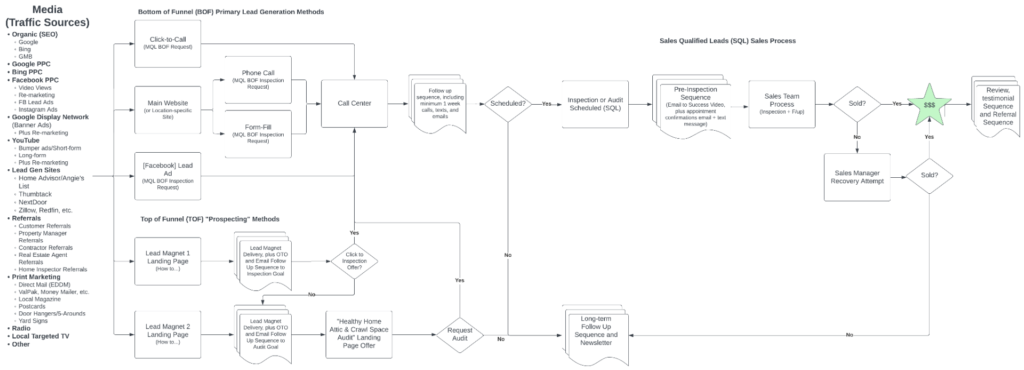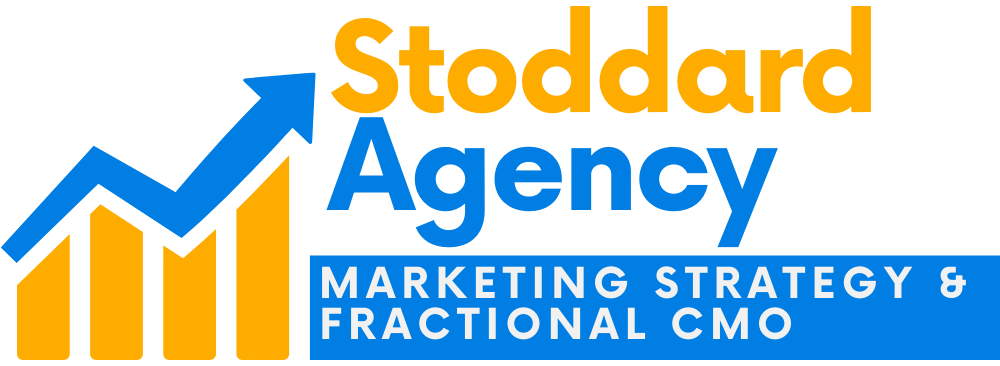Welcome to the latest edition of our newsletter series on scaling a home services business into a multi-state powerhouse. In this fourth part, we will discuss the Functional Systems Map, an essential tool for companies looking to grow and succeed.
I have helped several home services business owners make several million more annually by implementing this tool. The Functional Systems Map helps businesses identify growth areas, troubleshoot problem spots, and make better decisions by visualizing their processes.
This map is part of a more extensive functional marketing system that includes other documents and processes I have previously discussed. However, this article will focus solely on the Systems Map.
Creating a Systems Map requires a detailed-oriented approach, a crucial step in planning your business’s growth. You can start by identifying every process step, from prospecting to upselling, retention, and referrals. You can create this map using software like Lucidart or even a piece of paper.
This article will provide an overview of the Systems Map, including an example I created for a client. Remember, your Systems Map will look different, but the goal remains the same – to map out your business’s processes and identify areas for growth.

The Systems Map Overview
Now, let’s dive into the Systems Map itself. The Functional Marketing Systems Map® is a registered trademark that we use to give credit to the organization, CMOx, that developed this tool. The main difference between a systems map and a functional marketing systems map is that the latter is integrated into other systems, which feed into its creation.
The Functional Marketing Systems Map® is part of the CMOx processes, an organization that includes many smart CMOs, including Casey Stanton, who created the term. I have learned much from them and want to give credit where credit is due.
But don’t let the fancy term intimidate you. You can create a regular old systems map without using the registered trademark. The Systems Map we’re focusing on in this article visually represents your business’s processes.
To illustrate this, I have included an example of a Systems Map that I created for a client. Of course, your map will look different, but the idea is to map out your business’s processes visually.
The Systems Map is essential for any business looking to scale and grow. It helps you identify areas for improvement and opportunities for growth, which ultimately enables you to make better decisions and save money. So, let’s get started and create your own Systems Map.
Media Sources
Let’s discuss the different media sources contributing to your business’s traffic. A diversified media approach is crucial, rather than relying on a single source. The Systems Map helps you identify all your media sources, including organic SEO, Google Pay-per-click, Facebook Pay-per-click, video ads, and display network ads, direct mail, radio, etc.
You can also include additional offline sources like referrals, print marketing, radio, TV, and yard signs. The idea is to list all your sources and test each to see what works best for your business.
Old media is not dead; it can sometimes work better than new media. However, by combining online and offline media sources in multimedia, the multichannel approach can increase engagement and collect more information about your customers. For example, you can start with a yard sign, and the customer can call a phone number to receive an email or a free report. You can then send them a letter or postcard to follow up, while retargeting them on Facebook.
Remember, the key is to have a diversified media approach and test each source to see what works best for your business. The Systems Map lets you identify traffic sources and visualize your business’s growth opportunities.
Bottom of the Funnel
Most businesses are already focused at the Bottom of the Funnel (BOF), or at least partially. These are the people who are ready to buy now. The BOF differs from the Top-of-the-Funnel (TOF), where people are just becoming aware of your business or services. The BOF is where the best leads are, as they are sales-ready. However, the vast majority of people are not at the BOF yet, only about 5% are. So, while having a solid BOF strategy is essential, you must also focus on moving people from the TOF to the BOF.
In this case, we have a click-to-call marketing strategy, where people can directly call the business from an ad, such as on Google Ads or Local Service Ads. This results in marketing-qualified leads at the BOF.
MQL and SQL
The marketing-qualified lead is a prospect who has shown interest in your services by filling out a form, making a phone call, or providing an email address. On the other hand, a sales-qualified lead has scheduled an appointment or inspection with your sales team. The process begins with suspects, who may be interested in your services, and then moves on to prospects who have expressed curiosity or interest.
Once a prospect becomes a marketing-qualified lead, they enter a follow-up sequence, which includes at least one week of calls, texts, and emails. If they schedule an appointment, they become a sales-qualified lead. However, even if they cancel the appointment or fail to close the sale, they are still considered a marketing-qualified lead.
The call center handles the transition between marketing and sales, focusing on moving prospects through the funnel and converting them into sales-qualified leads. The key is documenting the process, including all calls, texts, and emails, and focusing on providing high customer service and engagement.
Long-Term Follow-Up
The long-term follow-up sequence is an essential part of the funnel and involves keeping in touch with leads and customers even after the initial contact or sale. This consists of email sequences, occasional phone calls, and text messages. However, it’s also vital to include direct mail and print marketing, such as a print newsletter, as studies have shown that this can significantly increase retention, sales, and referrals. The long-term follow-up sequence should be personalized based on whether the lead is marketing-qualified or sales-qualified. For closed sales, there may be a different follow-up sequence to generate reviews and referrals. It’s important not to forget about lost leads, as there may be opportunities to sell to them in the future.

Top of the Funnel Prospect Attraction
The Top-of-the-Funnel prospect attraction is where the most significant opportunity lies, and many businesses are not doing it well. This part of the funnel focuses on attracting prospects not yet ready to buy through information-first marketing. This can be achieved by offering lead magnets, valuable content, or information accessed through a landing page. Once a prospect opts in, they should receive the lead magnet and a one-time offer. The one-time offer is a special deal that might appeal to those ready to buy now, even though they are at the top of the funnel. If they accept the offer, they will be directed to the call center for a sales appointment.
If they do not take up the one-time offer, they will receive a follow-up email sequence and may be presented with another lead magnet on a different topic. They will then be directed to a landing page that offers a special, unique, and compelling deal for an inspection or audit. If they accept the offer, they will be directed to the call center for a sales appointment. They will be placed in a long-term follow-up sequence if they do not accept the offer.
It is essential to capture the leads at the top of the funnel and follow up with them through a long-term follow-up sequence, even if they are not yet ready to buy. Service businesses often drop the ball here, failing to do anything with leads that are not yet ready to buy. Businesses should not view these leads as a waste of money but should nurture them until ready, or at the very least sell them to other companies or referral partners (“cross-pollinate” or cross-promote with other service providers), or find a way to add the service themselves and sell it or sub it out.
Conclusion
I hope this overview of the sales and marketing funnel and systems map has been helpful to you. Remember that the key takeaways are to create a visual guide to your whole business, defend your systems map, make people prove where their shiny new object idea fits in, and master one target market at a time.
Don’t forget to involve your marketing and sales team in creating and improving your systems map and ensure they understand and maintain its integrity. If you need help creating your systems map, visit www.getleadsfirst.com for special offers and additional information.
Thank you for taking the time to learn about this critical aspect of your business, and I wish you success in implementing it.





